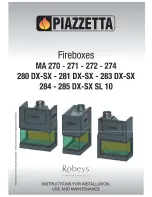
SITE REQUIREMENTS (continued)
Clearances to non-combustibles
Non combustible surfaces are defined as brick, metal, marble, concrete etc. and also a number of man-
made materials impervious to flame. If in doubt refer to the material manufacturer for further information
before proceeding with installation.
The wall/back panel for the opening must always be non-combustible. Bare plasterboard must be protect-
ed by non-combustible plaster or replaced with non-combustible material (e.g. Superlux board). Any gap
between wall boards and the wall must be filled using glass fibre insulation, silicone mastic or similar mate-
rial to prevent heat ingress.
Any type of fire surround used with this appliance must be adequately sealed to the wall and floor to pre-
vent excess draughts around the back of the fire. The temperature rating of any surround used must be
150°C minimum.
Clearances to the sides of the appliance are 100mm (4”). Clearance to the front of the appliance is 500mm
(20”).
The sides and back of the appliance may be installed directly onto a non-combustible surfaces.
A non combustible shelf of any depth may be positioned above the appliance provided it is no closer than
200 mm from the top of the appliance glass panel and the wall above the appliance is non combustible.
The shelf itself and any articles placed on it must also be tolerant of high temperatures.
Clearances to combustible materials
Combustible materials are defined as wood, fabrics, or other materials likely to combust if exposed to
flame. Generally, any material, which is likely to discolour, melt or misshape when exposed to moderate
heat, should be considered as a combustible material or surface.
Clearance to the sides of the appliance facia are 100mm (4”) but curtains, drapes and other fabrics are not
permitted within a distance of 500mm (20”) of the appliance sides. No such materials are permitted direct-
ly above the appliance regardless of distance.
The minimum clearance to the ceiling above the appliance is 800mm (31.5”) measured from the top of the
appliance glass panel.
Combustible materials should not be positioned directly in front of the appliance within a distance of one
metre.
A combustible shelf may be fixed to the wall above the fire, providing that it complies with the dimensions
given below.
The shelf depth may be greater but the height must also be increased accordingly. An increase in height of
25 mm is required for every 12.5 mm of additional shelf depth. For shelves that are too low protective
devices can be used such as metal heat deflectors, but it must be assured that the shelf does not reach an
unacceptable temperature before relying on such a solution.
Under no circumstances should any electrical equipment e.g. plasma screen TV sets etc. be positioned on
the wall above the appliance.
Clearance to the sides and rear of the firebox are a 75mm (3“) air-gap. Clearance to the top of the firebox
is a 100mm (4”) air-gap.
It should be established that any mirrors or picture frames etc. to be positioned on the wall above the appli-
ance are able to withstand prolonged exposure to moderate heat and moisture before proceeding with their
installation.
If the appliance is to be mounted on a dry lined wall or a timber framed construction wall then the integri-
ty and ability of the wall to carry the weight of the appliance must be confirmed. It is important in these cir-
cumstances that any vapour control barrier is not damaged, and that any structural members of the house
frame are not damaged - refer to section 6.5.
4.0
Maximum depth of shelf Minimum distance from hearth to underside of shelf
150mm
950 mm
100mm
850 mm
4
©
2009 Focal Point Fires plc.







































